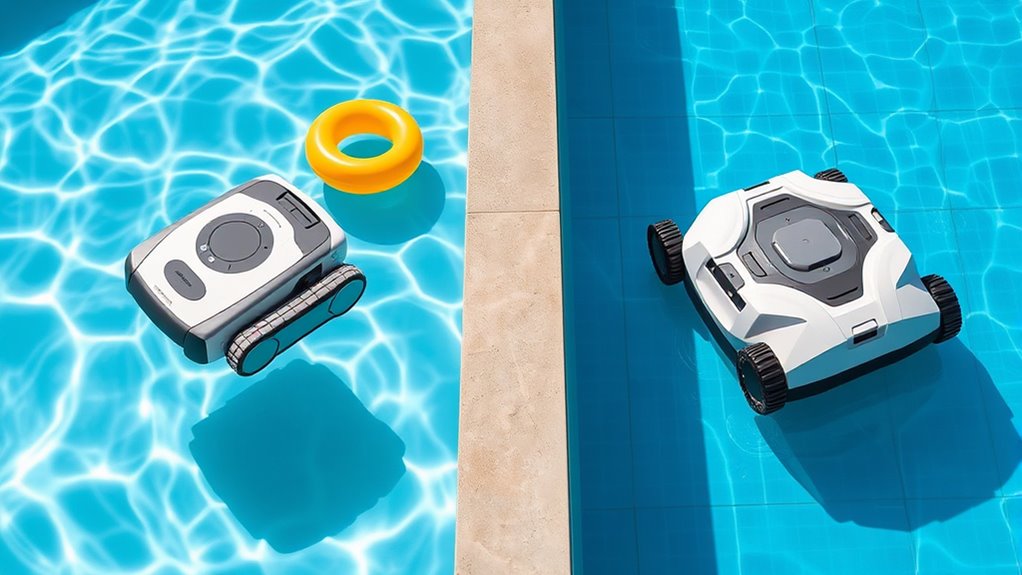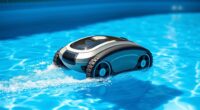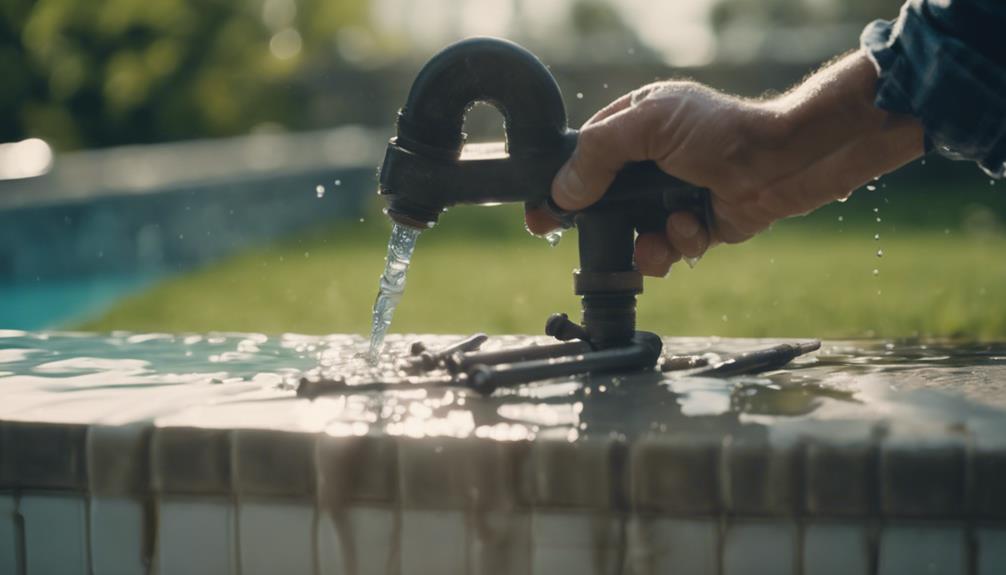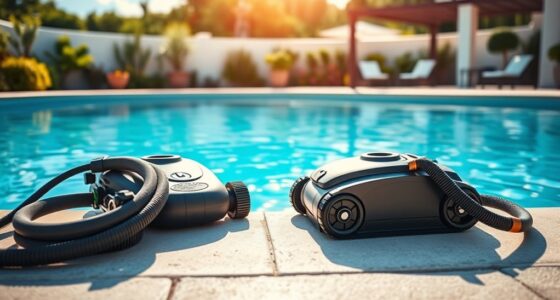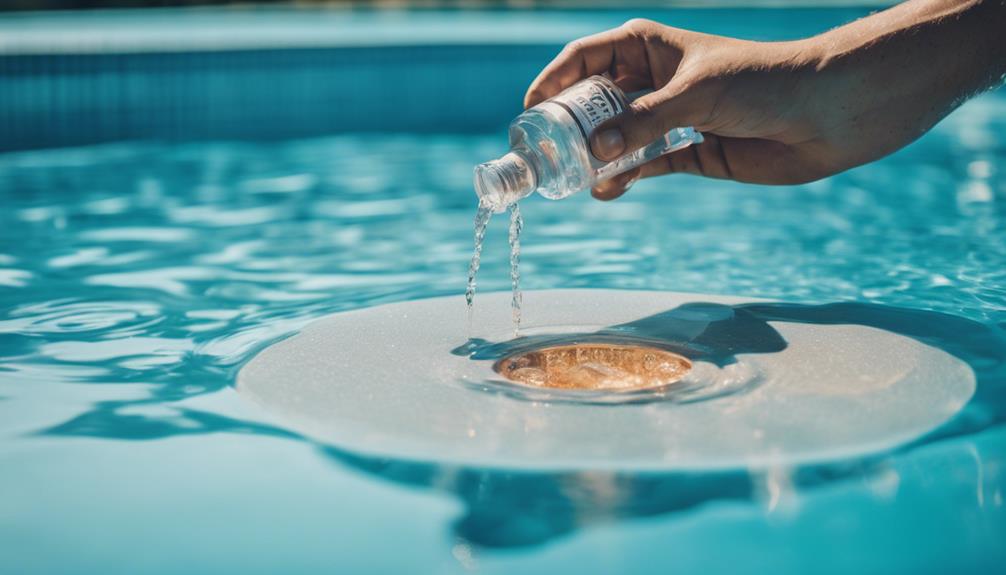Robotic pool cleaners for above-ground and in-ground pools differ based on pool design, size, and surface materials. Above-ground models are usually smaller, lightweight, and better suited for simple shapes, while in-ground models are more advanced with flexible navigation for complex layouts. Both types feature different cleaning modes and tech options to handle debris and surfaces effectively. To find the best fit for your pool setup and get tips on maintenance, explore further.
Key Takeaways
- Above-ground pools are generally easier to navigate with smaller, lightweight robots, while in-ground pools require larger, more advanced models.
- Surface materials and pool design influence the choice of robotic cleaners, with smoother surfaces favoring simpler models.
- In-ground pools often demand durable, high-tech cleaners with sophisticated navigation features to handle complex layouts.
- Cost and maintenance vary, with above-ground cleaners typically being more affordable and easier to service.
- Proper calibration, scheduling, and pool preparation optimize cleaning efficiency for both pool types.
Differences in Pool Structures and Cleaning Needs

Understanding the differences in pool structures is essential when choosing a robotic cleaner, as each design presents unique cleaning challenges. The pool material profoundly influences the cleaning process; for example, fiberglass and vinyl pools often have smooth surfaces that are easier to clean, while concrete pools with textured finishes may require more thorough scrubbing. The installation process also varies: above-ground pools typically have simpler setups, making them easier for robotic cleaners to navigate, while in-ground pools often involve more complex construction and additional features like stairs or ledges. Recognizing these differences helps you select a robotic cleaner suited to your pool’s material and structure, ensuring effective cleaning without damaging surfaces or struggling to reach difficult areas. Additionally, surface textures can significantly impact the effectiveness of cleaning, as rougher surfaces may trap more debris and require more powerful or specialized robotic cleaners.
Size and Compatibility of Robotic Cleaners
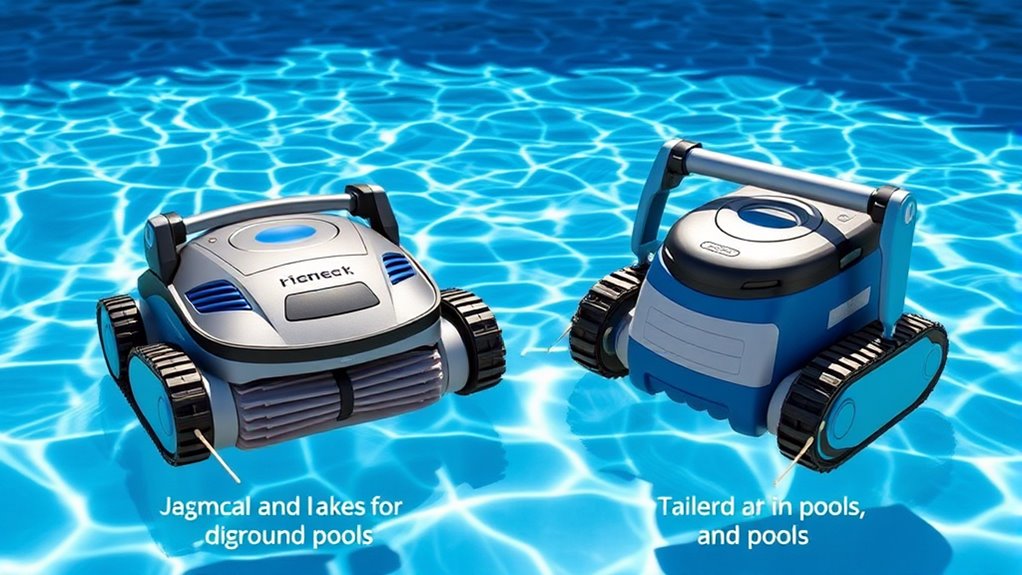
Choosing a robotic pool cleaner that fits your pool’s size and shape is essential for peak performance. For above-ground pools, verify the cleaner is compatible with the pool shape—round, oval, or irregular—and can navigate tight corners or curved surfaces. In-ground pools often have more complex shapes, so select a model with adjustable or flexible navigation features. Material durability is also key; a sturdy, weather-resistant design ensures your cleaner withstands exposure to the elements and frequent use. Verify that the cleaner’s size suits your pool’s dimensions—larger models may struggle with small or narrow spaces, while smaller units might not cover extensive areas efficiently. Proper compatibility guarantees thorough cleaning and prolongs your robotic cleaner’s lifespan. Additionally, understanding the cost and budget considerations can help you choose a model that offers the best value for your investment. Ensuring the cleaner is designed with suitable navigation technology can make a significant difference in cleaning efficiency across different pool types. Incorporating advanced sensors can help prevent the cleaner from missing spots or getting stuck, thus improving overall cleaning performance. Furthermore, considering water type and debris levels can optimize the cleaner’s performance and longevity. Being aware of the pool maintenance requirements can also guide you in selecting a cleaner that aligns with your upkeep routine.
Features and Technology Variations
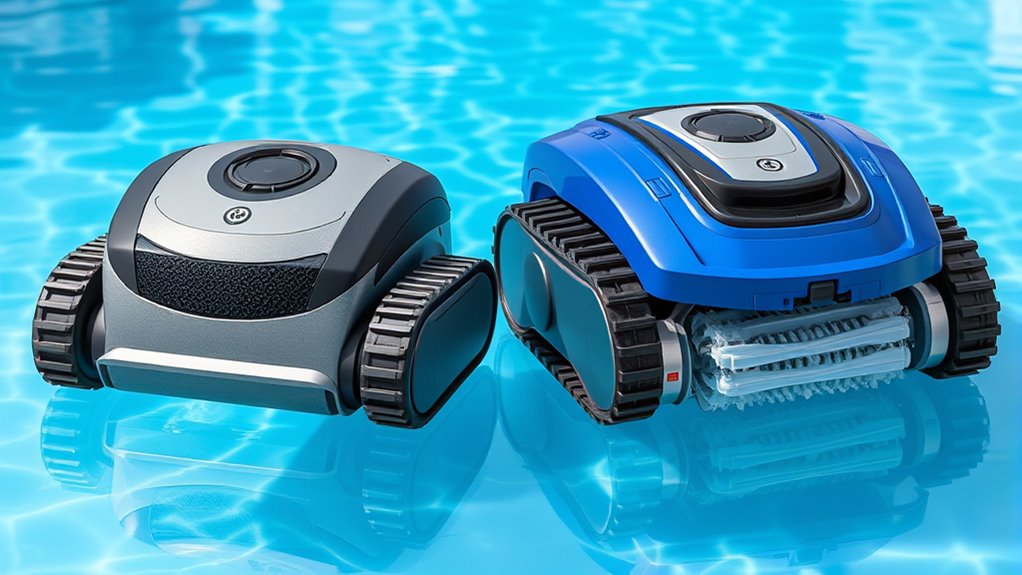
Robotic pool cleaners come with a range of features and technology options to suit different needs. You’ll find models with advanced navigation and mapping, making cleaning more efficient, along with various power modes for different debris. Understanding these variations helps you choose a cleaner that best fits your pool size and cleaning preferences. Some models are designed specifically for self-watering plant pots, incorporating moisture sensors and water management features to optimize cleaning cycles. Additionally, some robotic cleaners include alimony laws and legal considerations to ensure compliance with regional regulations, which can be crucial for proper operation and maintenance. Incorporating layer concepts can also enhance the organization of the internal systems within these devices, leading to better performance and easier troubleshooting. Moreover, integrating emotional support principles can help users feel more confident and satisfied with their choice, especially when investing in advanced technology. Furthermore, considering headphone compatibility can be beneficial when users want to listen to music or guides during operation, enhancing their overall experience.
Pool Size Compatibility
Selecting a robotic pool cleaner that matches your pool’s size is essential for effective and efficient cleaning. Larger pools require models with longer run times and higher coverage capabilities, ensuring every part of the pool surface gets cleaned thoroughly. Smaller pools, on the other hand, benefit from compact units that can quickly finish the job without wasting energy. It’s also important to consider how your water chemistry affects cleaning needs; for example, pools with heavy algae buildup may need a model with stronger suction or scrubbing features. Make sure the cleaner you choose is rated for your pool surface type, whether it’s vinyl, fiberglass, or concrete, to prevent damage. Matching your robot to your pool’s size and surface guarantees maximum performance and longevity.
Navigation and Mapping Tech
Modern robotic pool cleaners incorporate advanced navigation and mapping technologies to guarantee thorough coverage of your pool. They use features like mapping accuracy to create detailed layouts, ensuring no area is missed. Obstacle detection helps prevent collisions with pool walls, ladders, or toys, reducing potential damage. These technologies enable the cleaner to plan the most efficient cleaning route, saving time and energy. Some models utilize infrared sensors, while others rely on gyroscopic or magnetic guidance. The level of sophistication varies, especially between above-ground and in-ground pool cleaners, affecting their ability to adapt to different pool shapes and complexities. Overall, these tech features markedly enhance cleaning performance and reliability, giving you peace of mind. Mapping precision is crucial for comprehensive cleaning coverage and efficient operation. Additionally, sensor technology continues to evolve, offering even smarter cleaning solutions tailored to various pool types. Modern advancements also include adaptive navigation systems, which allow cleaners to better handle complex pool layouts and obstructions. Furthermore, ongoing innovations in sensor integration contribute to more accurate obstacle detection and route planning, boosting overall efficiency.
Cleaning Power and Modes
Different cleaning modes and advanced technologies enable robotic pool cleaners to tackle various debris and dirt effectively. Some models offer multiple cleaning modes, such as spot cleaning, full pool coverage, or focused scrubbing, giving you flexibility based on your pool’s needs. The choice of filter types—fine mesh, ultra-fine, or multi-layer filters—affects cleaning efficiency and debris retention. Additionally, technology variations influence power consumption; more advanced cleaners might use sensors to optimize energy use, reducing operational costs. These features ensure thorough cleaning while conserving electricity. Whether you have an above-ground or in-ground pool, selecting a model with versatile modes and efficient filters will help you maintain a spotless pool with less effort and lower energy bills. Regular maintenance of the filters also plays a crucial role in prolonging the lifespan and effectiveness of your robotic cleaner performance features, and understanding pool types can help you select the most suitable cleaning mode for your specific pool. Incorporating energy-efficient technologies can further enhance the overall cost-effectiveness of your pool cleaning routine. Being aware of narcissistic behaviors can help in managing relationships with difficult personalities.
Ease of Use and Maintenance

Robotic pool cleaners are designed to make maintaining your pool straightforward and hassle-free. They often feature user-friendly interfaces, so you can easily select cleaning modes or schedule runs without hassle. Battery life is vital—longer-lasting batteries mean fewer interruptions during cleaning sessions. Many models offer quick recharging, so your cleaner is ready when you need it. Maintenance is minimal; simply rinse filters and check for debris regularly. Some models have self-docking capabilities, simplifying storage. Look for intuitive controls and clear indicators to streamline operation. Additionally, understanding tuning concepts can help when selecting models with optimal performance features. With these features, you’ll find cleaning less of a chore and more of a quick, simple task, letting you enjoy your pool more and spend less time on upkeep.
Cost Considerations for Different Pool Types

The cost of robotic pool cleaners varies considerably depending on your pool type, so it’s essential to take these factors into account before making a purchase. For above-ground pools, you’ll usually spend less initially, as smaller models and simpler features suffice. In-ground pools often require more powerful, advanced cleaners, which can add to the cost. Additionally, consider the long-term expenses, such as maintaining the pool cover to prevent debris buildup and ensuring proper chemical balance, which reduces strain on the cleaner and extends its lifespan. In-ground pools typically demand more frequent cleaning and maintenance, impacting overall costs. By understanding these differences, you can choose a robotic cleaner that fits your budget while effectively managing cleaning needs for your specific pool type.
Best Practices for Optimal Cleaning Performance
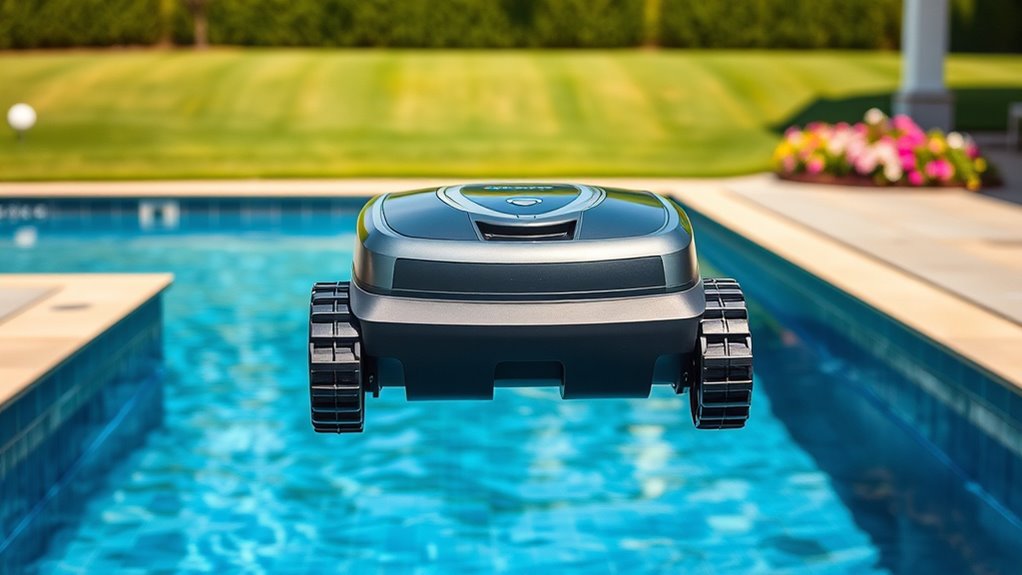
To get the best results from your robotic pool cleaner, you need to follow some simple best practices. Setting a proper cleaning schedule, placing the device correctly, and performing regular maintenance checks will keep it running smoothly. These steps guarantee your pool stays clean and ready for use at all times.
Proper Cleaning Schedule
Establishing a consistent cleaning schedule is essential for keeping your pool in top condition and ensuring your robotic cleaner performs at its best. Regular maintenance helps prevent buildup, keeps water clear, and extends your device’s lifespan. To optimize performance, align your cleaning routines with seasonal cleaning schedules and pool chemical maintenance. Consistency minimizes algae and debris, saving you time and effort.
Consider these best practices:
- Clean your robotic cleaner’s filter after each use
- Adjust cleaning frequency based on pool usage and weather
- Check water chemistry regularly to prevent imbalances
- Schedule deep cleaning at least once per season
A well-planned schedule ensures your pool stays pristine, reduces chemical usage, and guarantees your robotic cleaner runs smoothly year-round.
Correct Device Placement
Proper device placement is crucial for ensuring your robotic pool cleaner covers all areas effectively. Start by placing the cleaner on a flat, stable surface to enhance placement stability. Confirm the device is correctly calibrated before use; this helps it navigate efficiently and clean thoroughly. Position the cleaner in the pool’s center or near areas with heavy debris to optimize coverage. Avoid placing the device in spots with obstacles or uneven surfaces, as this can hinder movement and reduce cleaning efficiency. Check that all filters and brushes are securely attached to maintain device calibration during operation. Proper placement minimizes the risk of the cleaner getting stuck or missing spots, ultimately improving its performance and extending its lifespan.
Regular Maintenance Checks
Regular maintenance checks are essential for keeping your robotic pool cleaner operating at its best. Regularly inspect the device for debris or tangled cords, and clean its filters to guarantee top performance. Check the chemical balance of your pool water; unbalanced chemicals can hinder cleaning efficiency. Keep an eye on water temperature, as extreme heat or cold can affect the cleaner’s motor and sensors. Additionally, verify that the cleaner’s brushes and wheels move freely, and replace worn parts promptly. Proper maintenance helps extend your cleaner’s lifespan and maintains its cleaning power. By staying proactive with these checks, you’ll ensure your pool stays sparkling clean with minimal effort and avoid costly repairs later on.
Making the Right Choice for Your Pool Setup
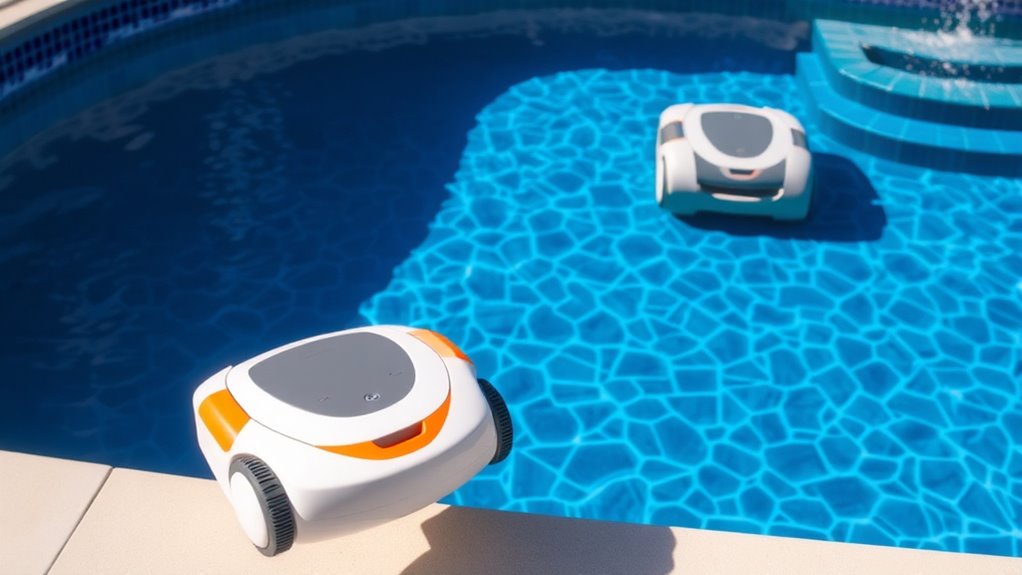
Choosing the right robotic pool cleaner depends on understanding your pool’s specific setup and needs. If you have an above-ground pool, look for a lightweight model that easily navigates around a pool cover or shallow areas. For in-ground pools, consider larger units with advanced navigation to cover extensive surfaces efficiently. Your decision should also factor in chemical balancing; a well-maintained pool with balanced chemicals reduces debris buildup, making cleaning more effective. If your pool has a cover, ensure the robot can maneuver over or around it without damage. Think about the size and shape of your pool, and whether the cleaner is compatible with your pool’s features. Making an informed choice guarantees superior cleaning and longevity for your pool setup.
Frequently Asked Questions
Are Robotic Pool Cleaners Suitable for Saltwater Pools?
Yes, robotic pool cleaners are suitable for saltwater pools. They typically feature salt compatibility and corrosion resistance, making them durable in salty environments. You should check the product specifications to verify your cleaner is designed for saltwater use. With proper maintenance, a robotic cleaner can efficiently keep your saltwater pool clean, providing hassle-free swimming without worrying about corrosion or damage.
How Long Do Robotic Cleaners Typically Last?
Robotic pool cleaners typically last around 3 to 7 years, depending on their durability lifespan and how well you maintain them. You should expect some wear and tear over time, especially with regular use. Proper maintenance requirements, like cleaning filters and checking brushes, can prolong their life. Investing in a quality model and following manufacturer guidelines helps guarantee your robotic cleaner stays efficient and lasts longer.
Can Robotic Cleaners Handle Algae or Heavy Debris?
Think of your robotic cleaner as a trusty garden hose, but for your pool. While it can handle light algae removal and small debris, heavy algae buildup and large debris may overwhelm it, like a floodgate. For tough algae or heavy debris, you might need to pre-clean or choose a model with stronger suction and specialized brushes. Your robotic is great for routine cleaning but may struggle with the heavy lifting.
Do Robotic Cleaners Require Professional Installation?
You don’t usually need professional installation for robotic pool cleaners. Most models have simple setup procedures, but you should check installation requirements and compatibility concerns before buying. Make sure your pool’s size and shape match the robot’s capabilities. If you’re unsure, consulting the manufacturer’s instructions or a pool professional can prevent issues. Overall, these cleaners are designed for easy use and quick setup, saving you time and effort.
Are There Eco-Friendly Options for Robotic Pool Cleaning?
You’re wondering if eco-friendly options exist for robotic pool cleaning. Yes, many energy-efficient models are available that use less power and reduce environmental impact. These eco-friendly options often feature smart navigation, efficient motors, and eco-conscious materials. By choosing these models, you can keep your pool clean while minimizing energy consumption and your carbon footprint. Look for certifications or features that highlight their eco-friendly design to make a sustainable choice.
Conclusion
Choosing the right robotic pool cleaner depends on your pool’s unique needs. Think of it as finding the perfect match—your pool’s shape, size, and structure are the puzzle pieces. With the right cleaner, you’ll transform cleaning from a chore into a breeze, turning your pool into a sparkling oasis. So, don’t just settle—select wisely, and let your pool shine like a gem waiting to be discovered.

